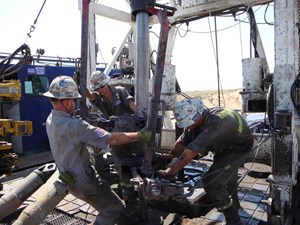Oil trades above $64 one year after it crashed below zero
SINGAPORE (Bloomberg) --Oil jumped above $64 a barrel, a year to the day after futures for the U.S. benchmark collapsed below zero, with the world’s most important commodity extending a powerful rally on bets for better demand.
West Texas Intermediate advanced 1.3%, adding to Monday’s modest climb as the dollar weakened, while production in Libya fell below 1 million barrels a day amid a budget dispute.
Oil’s forward curve also suggests growing confidence -- particularly as U.S. demand recovers -- with the spread between WTI’s contracts for December this year and 2022 at the widest backwardation in about a month. Yet there are still reasons to be cautious, with India suffering a fresh wave of coronavirus infections and refiners there starting to curb processing.
“Follow-through buying is pushing prices further up this morning but the immediate upside potential could be limited by the relentless march higher in infection rates,” said Tamas Varga, an analyst at PVM Oil Associates.
Crude is up more than 30% in 2021 on optimism that the reopening of economies will stoke consumption and keep draining global inventories. As demand picks up, the Organization of Petroleum Exporting Countries and its allies are planning a gradual return of supply starting next month. The alliance may skip a full-scale ministerial meeting planned for next week, possibly indicating members don’t see much need to revise current strategy.
Prices:
- WTI for May delivery, which expires Tuesday, rose 1.3% to $64.21 a barrel at 10 a.m. London time
- The more active June contract gained 1.4% to $64.33
- Brent for June settlement traded up 1.5% at $68.03
- Brent’s prompt spread is also backwardated, suggesting a tightening supply picture
A year ago today, the global oil market faced an unprecedented crisis, with WTI closing at -$37.63 a barrel. Prices went negative after lockdowns savaged demand and key producers Saudi Arabia and Russia flooded the market in a price war. A restoration of OPEC+ unity marked by deep supply cuts, as well as the development of vaccines, have helped prices to climb back.
“The market’s recovery through the past year, though still clouded by uncertainty, makes a repeat of the April 2020 price crash highly unlikely,” said Vandana Hari, founder of Vanda Insights in Singapore. “Some of the circumstances were unique to last year and the initial weeks of the pandemic, such as the confluence of the unanticipated shock of global lockdowns and demand destruction and OPEC+ opening the spigots.”
Related news:
- Libya’s oil production fell as a budget dispute hindered its ability to fix war-damaged infrastructure. The National Oil Corp. said the central bank’s “refusal” to release money to the energy sector had forced local producers to pump less.
- India’s Mangalore Refinery & Petrochemicals Ltd. has cut processing rates and will likely have to shut down one of its units as a deadly Covid-19 wave pummels fuel demand.
- Chinese President Xi Jinping called for greater global economic integration, while calling on the U.S. and its allies to avoid “bossing others around.”



